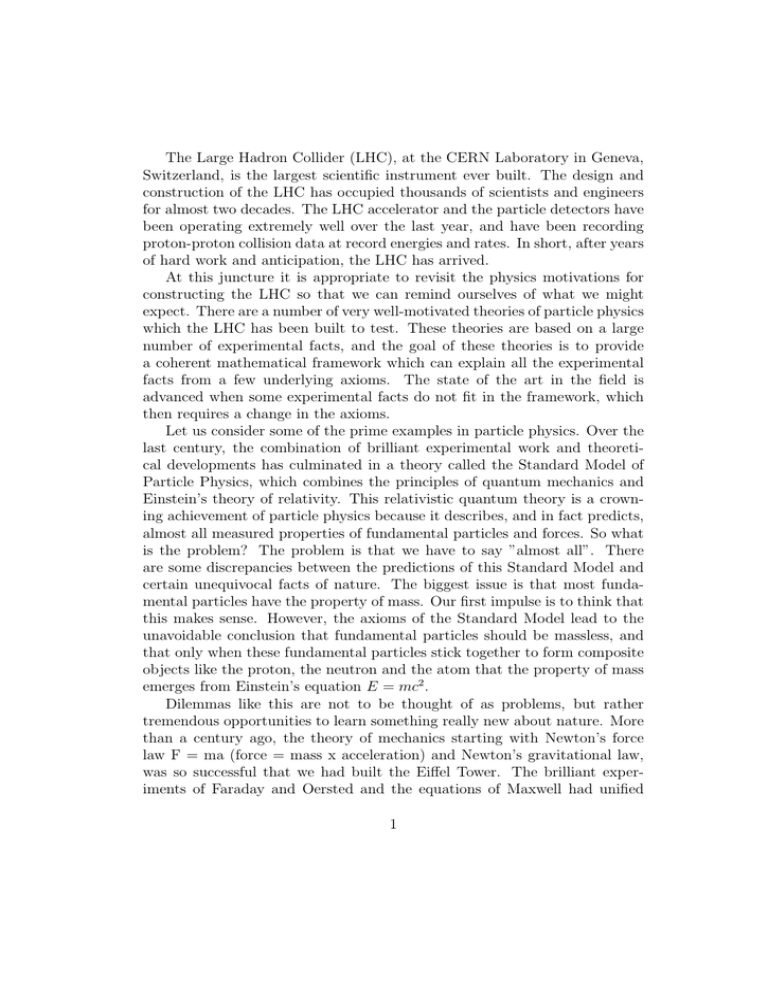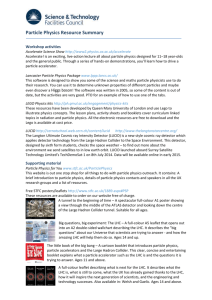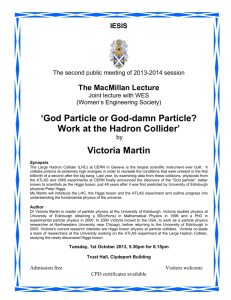The Large Hadron Collider (LHC), at the CERN Laboratory in... Switzerland, is the largest scientific instrument ever built. The design...
advertisement

The Large Hadron Collider (LHC), at the CERN Laboratory in Geneva, Switzerland, is the largest scientific instrument ever built. The design and construction of the LHC has occupied thousands of scientists and engineers for almost two decades. The LHC accelerator and the particle detectors have been operating extremely well over the last year, and have been recording proton-proton collision data at record energies and rates. In short, after years of hard work and anticipation, the LHC has arrived. At this juncture it is appropriate to revisit the physics motivations for constructing the LHC so that we can remind ourselves of what we might expect. There are a number of very well-motivated theories of particle physics which the LHC has been built to test. These theories are based on a large number of experimental facts, and the goal of these theories is to provide a coherent mathematical framework which can explain all the experimental facts from a few underlying axioms. The state of the art in the field is advanced when some experimental facts do not fit in the framework, which then requires a change in the axioms. Let us consider some of the prime examples in particle physics. Over the last century, the combination of brilliant experimental work and theoretical developments has culminated in a theory called the Standard Model of Particle Physics, which combines the principles of quantum mechanics and Einstein’s theory of relativity. This relativistic quantum theory is a crowning achievement of particle physics because it describes, and in fact predicts, almost all measured properties of fundamental particles and forces. So what is the problem? The problem is that we have to say ”almost all”. There are some discrepancies between the predictions of this Standard Model and certain unequivocal facts of nature. The biggest issue is that most fundamental particles have the property of mass. Our first impulse is to think that this makes sense. However, the axioms of the Standard Model lead to the unavoidable conclusion that fundamental particles should be massless, and that only when these fundamental particles stick together to form composite objects like the proton, the neutron and the atom that the property of mass emerges from Einstein’s equation E = mc2 . Dilemmas like this are not to be thought of as problems, but rather tremendous opportunities to learn something really new about nature. More than a century ago, the theory of mechanics starting with Newton’s force law F = ma (force = mass x acceleration) and Newton’s gravitational law, was so successful that we had built the Eiffel Tower. The brilliant experiments of Faraday and Oersted and the equations of Maxwell had unified 1 electricity and magnetism into a single theory of the electromagnetic force, leading to revolutionary predictions of radio waves, microwaves, and X-rays and electrical power generation and distribution. Yet, as these developments were changing our daily lives, there were subtle mathematical discrepancies in these theories that were noticed by physicists including Planck and Einstein. New paradigms were developed to resolve these issues, that resulted in the formulation of quantum mechanics and the theories of relativity, the two cornerstones of 20th century physics. One look around any room, with all the computers, telephones and audio-visual equipment is enough to testify to the impact of quantum mechanics. In order to incorporate the masses of fundamental particles in the working theory of massless particles, an additional axiom has been added to the theory. This is the postulate of the Higgs boson. Under this postulate, the Higgs permeates all of space, and as a fundamental particle like an electron propagates through space, its interaction with the Higgs imparts the property of mass. This is radical postulate, implying that even empty space is not really empty but is actually filled with the Higgs. One of the primary motivations for the LHC is to confirm or refute the Higgs postulate. The LHC is designed to have enough particle collision energy that it should be possible for some of these collisions to create ripples in the Higgs. These ripples would manifest experimentally as the Higgs boson, a new particle. This particle would be quite unstable, decaying immediately into other known particles whose experimental signature can be detected. There are two large particle detector experiments, with the quaint acronyms ATLAS (for A Toroidal Lhc ApparatuS) and CMS (for Compact Muon Solenoid), each as large as a multi-storey building and weighing thousands of tons, to detect the decay products of the Higgs boson and other particles. Since the Higgs boson has not been observed in past experiments, we know that it must have a very small production probability (according to quantum mechanics, all atomic and sub-atomic processes have a probabilistic description). Therefore it is going to take a very large number of collisions such that even with the tiny probability, enough Higgs bosons can be produced and detected in order to be sure. The LHC is now colliding 100 billion protons about 20 million times every second, but even at this prodigious collision rate, it may take another year or two for enough Higgs bosons to show up. Physicists are collecting and analyzing the data round the clock in eager anticipation. 2 The scientific case for the LHC is much broader than the Higgs boson. Another strong motivation comes from some very exciting astronomical observations. One of these was the measurement of the speeds of a large number of stars as they orbit the center of the galaxy. As we all know from swinging a rock at the end of a string, it takes a centripetal force to rotate a massive object in a circle. The higher the speed, the larger the force required. The observations show that the stars at large distance from the galactic center are moving too fast, in comparison to the gravitational force exerted by the galaxy’s visible mass. One way to explain this observation is to postulate additional matter in the galaxy which is not luminous, and therefore cannot be seen by any radiation but only sensed by its gravitational effect. This is the hypothesis of the so-called ”dark matter”, and the observations indicate that there could be four times as much dark matter as the known matter content of galaxies. Based on calculations in particle physics and astrophysics, the very exciting possibility has emerged that the dark matter may actually be a galactic cloud of very heavy sub-atomic particles, each with a mass larger than that of a gold atom. The expected properties of these new particles make it possible for them to be produced at the LHC. The discovery of dark matter particles would allow us to measure their properties as more LHC data are accumulated, and help us understand not only how galaxies formed in the first place, but also give us deep insights into the nature of space itself. Yet another exciting possibility is that the LHC will help us understand a quantum theory of the gravitational force. Einstein’s theory of General Relativity is, to the best of our knowledge, the correct theory of the gravitational force. However it is not a quantum theory, whereas we have verified quantum theories of the other forces. The development of the correct quantum theory of gravity has been a goal for almost a century, which even Einstein worked on for decades later in his career. Needless to say, this is a very difficult project in theoretical physics. Recent progress suggests that the LHC could lead the way to the correct theory by providing evidence for gravitons as the quantum mediators of the gravitational force. These new particles would leave well-identifiable signals in the particle detectors at the LHC. Since Einstein’s gravity theory is actually a theory of space and time, the discovery of gravitons would revolutionize our understanding of these concepts at the microscopic level, with far-reaching consequences that are beyond imagination. Looking beyond its great value as an instrument of fundamental science, the LHC also represents an achievement in international collaboration. Grand endeavours of the past, such as the Egyptian pyramids or the great 3 wall of China, have been pursued for the sake of glory or national defense. Regardless of the motivation, these civilizations built everlasting monuments. The LHC transcends political boundaries and brings so many countries together, for the sake of creating everlasting knowledge. 4




